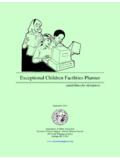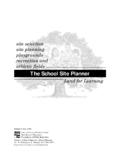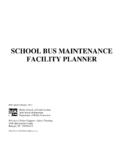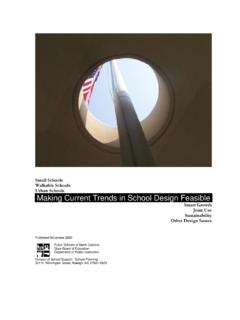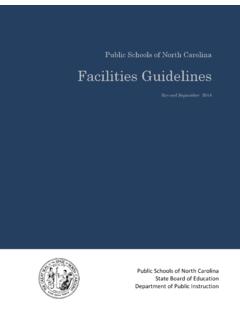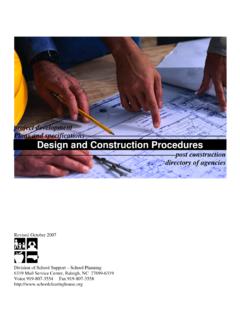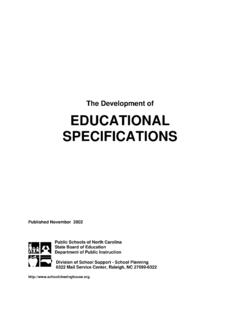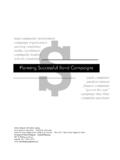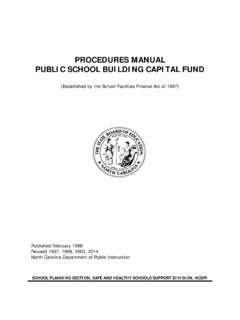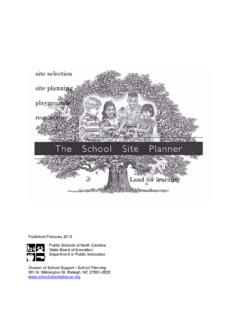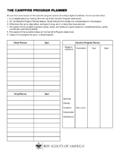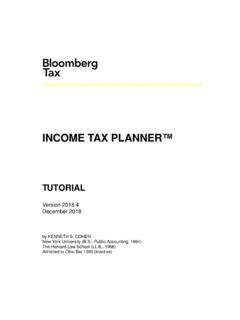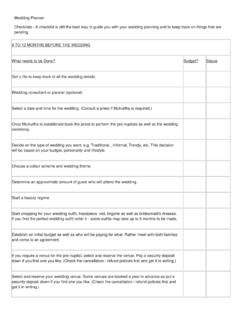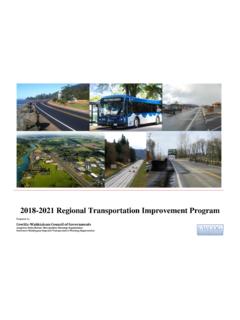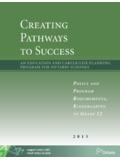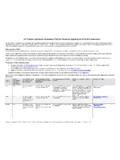Transcription of Arts Education Facilities Planner - …
1 Dance music arts Education Facilities Planner theatre arts visual arts Grades 9-12 Published November 2000 Public Schools of North Carolina State Board of Education Department of Public Instruction Division of School Support School Planning 301 N. Wilmington Street, Raleigh, NC 27601-2825 In compliance with federal law, including the provisions of Title IX of the Education Amendments of 1972, N C Public Schools administers all state-operated educational programs, employment activities and admissions without discrimination because of race, religion, national or ethnic origin, color, age, military service, disability, or gender, except where exemption is appropriate and allowed by law. arts Education Facilities Planner FOR GRADES 9-12 iii FOREWORD arts Education is a collective term that denotes instruction and learning in four separately distinct subject areas--dance, music, theatre arts , and visual arts .
2 Each is a unique but integral component of the North Carolina Standard Course of Study for kindergarten through grade twelve. Facilities that effectively support arts Education curricula must interrelate with overall school design while addressing the unconventional requirements of laboratory-oriented instruction. Much of the study, learning, and practicum for arts Education necessitates peculiar environmental considerations and results in performance or display of an art product. Instructional spaces should be designed and equipped to promote each type of teaching and learning and to provide maximum safety for students during the arts process. This document suggests Facilities necessary to conduct instruction in the four arts programs in grades 9-12 and conveys essential features that should be present.
3 It is a supplement to the North Carolina Public Schools Facilities Guidelines and is a resource to assist design professionals to plan arts Education Facilities that meet the needs of and complement dance, music, theatre arts , and visual arts programs in North Carolina=s public schools. We hope you find it useful. Phillip J. Kirk, Jr., Chair Michael E. Ward, State Superintendent State Board of Education North Carolina Department of Public Instruction iv ACKNOWLEDGMENTS The Department of Public Instruction gratefully acknowledges the contributions of the following, without which the development of this publication would have been difficult. arts Education Coordinators of North Carolina Ballard, Roger, AIA, Consulting Architect, School Planning Section, Department of Public Instruction, Raleigh, NC.
4 Cougle, Bryar, Theatre arts and Visual arts Consultant, arts Education and Healthful Living Section, Department of Public Instruction, Raleigh, NC. Dance Association of North Carolina Educators Edwards, David, , Education Consultant, School Planning Section, Department of Public Instruction, Raleigh, NC. Glendave, Incorporated: Photo Lab Specialists, Lewisville, NC. Hancock, Preston, , Dance and Music Consultant, arts Education and Healthful Living Section, Department of Public Instruction, Raleigh, NC. North Carolina Art Education Association North Carolina Music Educators Association, Inc. North Carolina Theatre arts Educators Wenger Corporation, Owatonna, MN. (1) (1) Much of the material and many of the illustrations included in the Sound Management, Sound Isolation, and Acoustical Design sections of this publication and in the Cubic Volume for Choral and Instrumental Music Rooms, Acoustics, Storage, Traffic Flow, Security, and Equipment sections of the Appendix are based upon the Planning Guide for Secondary School 4 Facilities , 1997, published by the Wenger Corporation of Owatonna, Minnesota.
5 This information is included by permission of the Wenger Corporation. v CONTENTS Background and About arts Using the Common Facilities Sound Sound Acoustical Teacher Performance Small Alternative Teaching General Choral Instrumental vi Support Theatre Black Box Visual arts Education Program Cubic Volume for Choral and Instrumental Music The Music Sample General Choral Instrumental Electronic Keyboard Theatre arts Black Box Theatre arts
6 Visual arts Photography Additional 76 1 INTRODUCTION BACKGROUND AND OVERVIEW The arts have been a part of life from the very beginning. They have defined, described, and deepened the human experience and have been an inseparable part of the human journey. All people have an abiding need for meaning--to connect time and space, experience and event, body and spirit, intellect and emotion. Art is created to make these connections--to express the inexpressible--and to connect each new generation to those that have gone before. Many factors impact arts Education programs in a high school. The demand for and extent of Facilities for the arts should be a collective decision among design professionals, school staff and administrators, community representatives, and others who share interest in their development and use.
7 To design optimum Facilities for arts Education instruction, it is helpful to have some fundamental knowledge about how programs are defined and prescribed for the public schools in North Carolina. Preconceived notions about arts Education programs may not accurately correlate with the intent of formal programs of study. In order to effectively collaborate with school personnel and make informed design choices and decisions, the designer should possess a basic sense of what arts Education comprises and of what an Education in the arts achieves, in relation to student learning. Study and instruction in the arts occur in traditional and non-traditional ways. In order for learning to be followed by practical application, arts Education programs often require non-traditional spaces with non-traditional features.
8 Examples include stages with theatrical lighting and dance studios with resilient floors. Much of the rationale for the scope and design of arts Facilities should stem from a clear understanding of the potential of arts Education programs and the realities of the programs that will be delivered at the school for which the design is being created. The following provides insight into instruction and learning that should take place in the completed facility. ABOUT arts Education Each student, regardless of background, talent, or disabilities, deserves access to the rich Education and understanding that the arts provide. In an increasingly technological society overloaded with sensory data, the ability to perceive, interpret and evaluate such stimuli is critical. The arts can help the student develop multiple capabilities for understanding and deciphering an image- and symbol-laden world, and should be considered an integral part of all general Education .
9 2 The North Carolina Standard Course of Study identifies what students in grades K-12 should know and be able to do as a result of a comprehensive arts Education . By involving the whole child, the arts gradually teach literacy while developing intuition, sensitivity, reasoning, imagination, and dexterity. Society benefits because the student gains powerful tools for understanding human experiences, both past and present, by: collaborating and working in teams; making decisions creatively, where no prescribed answers exist; learning to respect and adapt to diverse ways of thinking, working, and expressing; learning problem recognition and solving involving expressive, analytical, and developmental tools in every situation; understanding the influence of the arts and their power to create and reflect on cultures; developing the essential senses of sight, hearing, smell, taste, touch, and kinesthetics as intellectual, emotional, physical, creative, and expressive acts.
10 Analyzing non-verbal communication and making informed judgments about cultural products and issues; and communicating effectively. Concepts critical to arts Education which directly influence Facilities design include: The comprehensive program is a sequenced learning experience across four arts disciplines. The arts require focused time for sequential study, reflection, and practice. Instruction in the arts must occur through a hands-on orientation. arts Education should promote interdisciplinary study and integration among and across the arts and other disciplines. Technology should enhance the student=s ability to synthesize, integrate, and construct new meanings from a wealth of resources and information. USING THE Planner This publication is a reference document for school Facilities designers.
